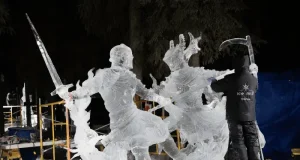
A large saltwater lake has appeared in Death Valley, one of the hottest, driest places in the Western Hemisphere. Named Lake Manly in honor of W. L. Manly, who led and heroically rescued the first party of white emigrants who entered Death Valley in 1849 it stretches across the floor of the valley. But it won’t be there long and the last time it appeared was in 2005.
Lake Manly is back after a rare significant rain fall in 2023. So, the time to see it is now, and most of the major roads into Death Valley are open (like California Route 190) with access to all the major park attractions like Zabriskie Point, Mesquite Flat Sand Dunes, Ubehebe Crater, Artists Drive, Golden Canyon/Gower Gulch Trails, and Racetrack Road, just to name a few.
Interestingly, the floor of Death Valley was part of a vast lake system during North America’s last major Ice Age. As the lakes vanished around 10,000 years ago, massive salt deposits were left behind creating the floor of the valley. There is also a vast aquifer system underneath Death Valley, a true American oasis.

Ancient waters bubble up from the ground to support an entire ecosystem at the Oasis at Death Valley, a secluded resort off of CA 190 tucked into the 3.4-million-acre Death Valley National Park (the largest park in the Lower 48). This winter vacation destination offers spring-fed pools averaging a comfortable 87 degrees, the lowest USGA golf course on earth, cascading bougainvillea-adorned gardens, and a spring-watered date palm grove.





